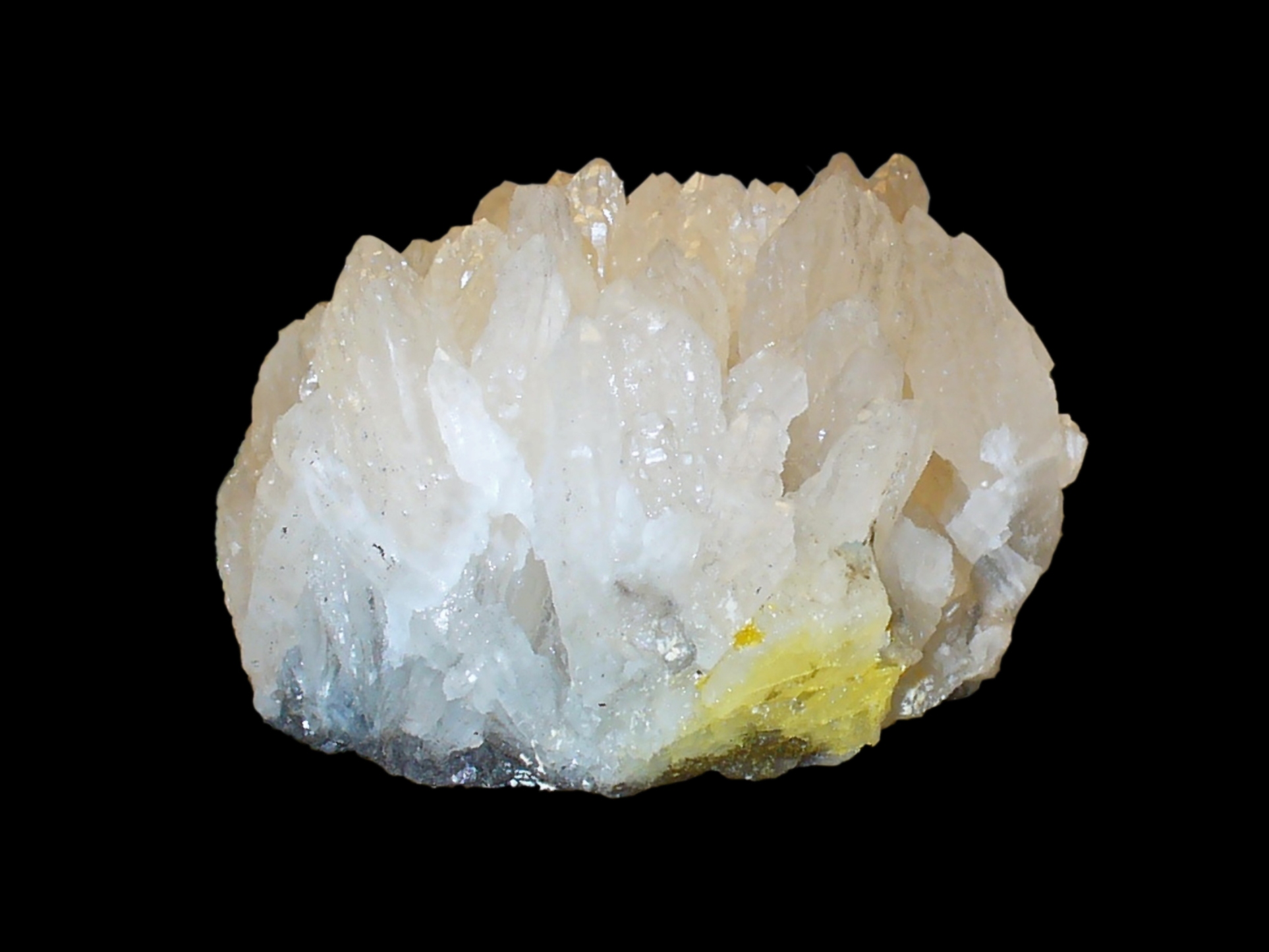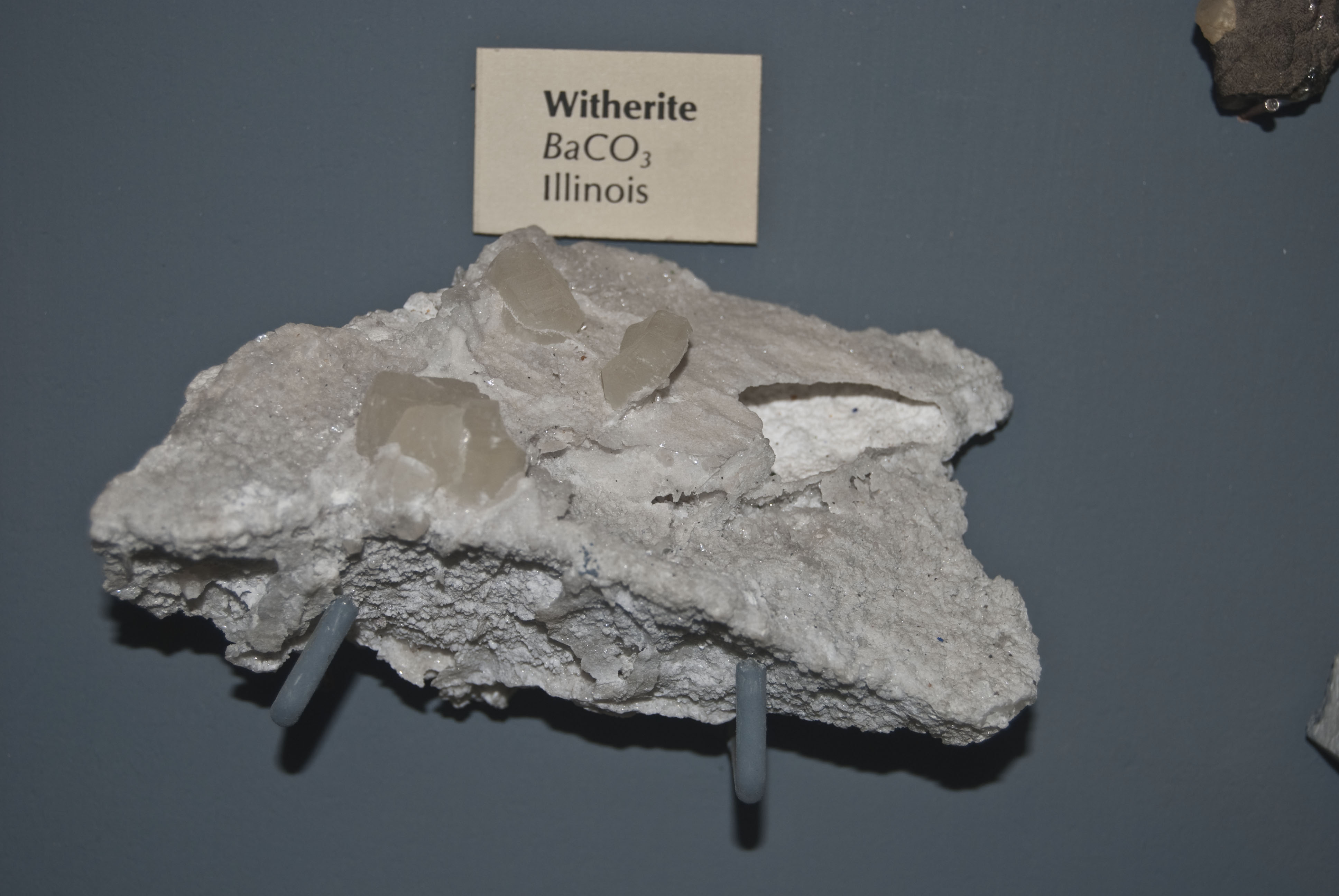Witherite Gemstone: Properties, Meanings, Value & More
 Witherite is a zeolite mineral often found as colorless to pale yellow or tan twinned crystals. It’s mostly recognized for its industrial uses and better known as a gemstone among collectors. The witherite pronunciation is WIH-thuh-rite.
Witherite is a zeolite mineral often found as colorless to pale yellow or tan twinned crystals. It’s mostly recognized for its industrial uses and better known as a gemstone among collectors. The witherite pronunciation is WIH-thuh-rite.
Is witherite rare? As a mineral, it’s uncommon, partly because it easily alters into barite. Cut witherite gemstones are quite rare, since they’re difficult to polish, they’re not very durable, and their dust is toxic to inhale.
Don’t get too scared, though — fashioned witherites are safe to touch and witherite crystals are safe for display.
In this guide, we’ll give you the entire breakdown on witherite gemstones, from their prices and properties to their history and how to handle them safely.
 Image credit: Rob Lavinsky, iRocks.com – CC-BY-SA-3.0
Image credit: Rob Lavinsky, iRocks.com – CC-BY-SA-3.0
About Witherite Stone
Witherite is a rare semi-precious gemstone and slightly unusual collector's mineral. Astrologically, witherite benefits Aquarius signs.
What is the common name for witherite? It may be called “barium carbonate” after its composition. Other monikers include:
Barolite
Sulfate-Carbonate of Baryte
Viterite
Aerated Barytes
Despite these names, witherite and barite aren’t the same. They’re related, but barite is a barium sulfate while witherite is a barium carbonate.
Industrially, what is witherite used for?
Witherite Uses
Despite being uncommon, witherite is the second most common barium mineral (after barite) and a significant barium ore. Most barium compounds are used for drilling mud.
Barium carbonate is used to make:
Glass
Ceramics
Paint
Soap
Dye
Plastics
Rubber
Cement
Explosives
Rat poison
Additional uses include hardening steel and controlling the ratio of chromate to sulfate in solutions for chromium electroplating. In the past, witherite was used in sugar refining.
Scientists have made synthetic witherite crystals to research its mineralogical properties.
 Image credit: Rob Lavinsky, iRocks.com – CC-BY-SA-3.0
Image credit: Rob Lavinsky, iRocks.com – CC-BY-SA-3.0
Witherite Specifications & Characteristics
As a barium carbonate mineral, the witherite chemical formula is BaCO3. Common impurities are calcium and strontium.
What mineral classification is witherite? Witherite is in the aragonite group of orthorhombic carbonates alongside cerussite, aragonite, and strontianite. Strontianite and witherite form a series.
Outside of crystals, witherite can be:
Globular
Granular
FIbrous
Botryoidal (resembling grape clusters)
Mammillary
Massive
Spherical
Tuberose (oval-shaped with protruding “bubbles” on surface)
Most witherite crystals are horizontally striated and twinned. Many crystals are trillings, meaning three intergrown crystals that twin at the center. These trillings can be bipyramidal and pseudo-hexagonal or elongated and pseudo-hexagonal. Other witherite crystals are prismatic, tabular, lenticular, or bladed.
What are the properties of witherite crystals? Here they are listed:
Mohs hardness: 3-3.5
Color: Colorless, white, gray, yellowish-gray, yellow, green, brown
Crystal structure: Orthorhombic
Luster: Vitreous; Resinous on fractures
Transparency: Transparent to opaque
Refractive index: 1.529-1.677
Density: 4.27-4.79
Cleavage: Distinct/good on {010}, poor or imperfect on {110} & {012}
Fracture: Uneven/irregular
Streak: White
Luminescence: Fluorescence, phosphorescence, and X-ray colors often present; Green, yellow, bluish-white, or violet in SW-UV & yellow or bluish-white in LW-UV; Bluish-white or yellowish phosphorescence; Fluorescence in X-rays
Pleochroism: None
Birefringence: 0.147-0.148
Dispersion: Low to weak
How Do You Identify Witherite?
Witherite’s most identifiable traits are its high density (heaviness) and low Mohs hardness.
A more complex identification method is acid testing. Witherite will dissolve and effervesce in cold, diluted hydrochloric acid and dissolve in sulfuric acid. However, these tests are a last-resort since they’re destructive.
Minerals often confused with witherite are strontianite, aragonite, and cerussite.
Cerussite is heavier (higher density) than witherite and has better cleavage. Aragonite and strontianite are less dense than witherite.
Pictured above: Blue jasperware teapot, Josiah Wedgwood and Sons, c. 1840, Chazen Museum of Art| Image credit: Daderot, Public Domain
Witherite History
The first description of witherite came from English physician and naturalist William Withering in 1784. Withering said the mineral came from the lead mine in Cumberland, England (now the Brownley Hill mine in Cumbria).
He first came across the stone in the collection of English businessman Matthew Boulton in 1782. Withering’s analysis proved the mineral was distinct from barite. He called witherite Terra ponderosa aerata, Latin for “aerated earth.”
German geologist Abraham Gottlob Werner renamed the stone “witherit” (later adjusted to “witherite”) in 1790 to honor Withering.
Scottish engineer James Watt, Jr. called the stone “aerated barytes” in 1790 and Irish geologist Richard Kirwan called it “barolite” in 1794.
Early Witherite Risks
Even before witherite’s official description, folks in Anglezarke, England knew the stone was hazardous.
A local farmer, Mr. Derbyshire, found many of his cattle dead from witherite. Others would use dumped witherite to poison rats or induce vomiting when sick. In one case, a man dosed his sick wife and child with the mineral, then watched them die over the next nine hours.
Dr. Charles Leigh, a physician and naturalist, recorded the case as proof of the mineral’s risks. James Watt, Jr. (mentioned earlier) also recorded the risks after experimenting with the mineral on animals.
Witherite “Jasperware”
One English entrepreneur experimented with witherite for pottery. Josiah Wedgwood was already renowned for his innovative ceramics when he started experimenting with witherite. After years of experiments, he created Jasperware in the 1770s.
Jasperware, or jasper ware, was an unglazed stoneware adorned with intricately carved cameos.
Despite the marketing name, the material didn’t contain jasper. The confidential (at the time) composition also varied. An 1800s analysis found it was around 57 percent barium sulfate, 29 percent ball clay, 10 percent flint, and 4 percent barium carbonate.
Wedgwood sold jasperware into the 1900s, and it’s still manufactured today.
 Image credit: H. Zell, CC-BY-SA-3.0
Image credit: H. Zell, CC-BY-SA-3.0
Witherite Healing Properties
As a typically white healing stone, witherite’s meaning reflects that of other white gemstones: purifying and protective properties and function as a crown chakra stone.
Metaphysically, witherite is used for spiritual development and insights into your purpose.
Emotionally, these crystals are said to dispel feelings of anxiety or despondency, replacing them with feelings of tranquility, confidence, and mental clarity.
Witherite Gemstone Properties
Witherite gemstone value depends on its color, cut, clarity, and carat weight.
Color
Most witherites are fairly unattractive shades of white to gray, and cut gems are usually colorless or white. However, witherites can also be pale shades of yellow, green, or brown.
Cut
Witherite stones are rarely cut, but some gem-quality crystals may be faceted. These are quite rare and valuable. Other translucent specimens may be cut into cabochons, but these are often pale and not very desirable.
Most witherite crystals are sold rough (uncut) for display.
Clarity & Transparency
Clarity describes the degree of visible inclusions in a gem, which can affect its transparency and value.
Most witherite gems have a sleepy look, which is usually caused by tiny inclusions. Witherite gems can also display banded growth structure.
Most faceted gems are more translucent, making transparent gems quite valuable.
Carat Weight & Size
Although witherite specimens can be large, rough gem-quality crystals are rarely over 25 carats (5 grams). As such, faceted witherites are typically small, with most under 5-10 carats. Cabochons may be slightly larger, but they’re not a common cut.
 Image credit: Cs california, CC-BY-SA-3.0
Image credit: Cs california, CC-BY-SA-3.0
Witherite Formation & Sources
How is witherite formed? Witherite usually forms in low-temperature hydrothermal environments. Hot fluids containing dissolved elements settle into these veins. From there, the rock cools and the water evaporates, allowing the elements to crystallize.
Another formation process involves barium replacing calcite, resulting in witherite as a byproduct. Part of witherite’s relative scarcity is because sulfuric acid from nearby sulfide minerals can easily change witherite into barite.
Common minerals associated with witherite are:
Galena
Calcite
Barite
Aragonite
Geographically, where is witherite found?
Mining Locations
The top sources for attractive witherite crystals are Illinois (USA) and England (UK).
Other sources include:
Austria
Canada
Czechia
France
Germany
Japan
Poland
Russia
Slovakia
Tasmania, Australia
USA (Arizona, Arkansas, California, kentucky, Montana, New York)
Wales, UK
Before you browse some witherite for sale, let’s discuss what prices to expect.
 Image credit: Ra'ike, CC-BY-SA-3.0
Image credit: Ra'ike, CC-BY-SA-3.0
Witherite Price & Value
Witherite can be fairly pricey, but its cost varies.
Faceted witherite gemstones range from around $20 to $200 per carat, with most falling around $40 per carat.
Rough witherite mineral specimens vary even more widely, ranging from around $40 to over $2,500 each. On average, witherite crystal specimens cost around $200 each.
Pricier specimens are generally large, translucent, well-developed, and/or attached to fluorite.
Before we wrap up, let’s go over gemstone care.
Witherite Care and Maintenance
Witherite is toxic if ingested, which usually happens if you inhale witherite dust created when the stone is cut or scratched. This is a greater risk to lapidaries (gem cutters), who have to take abundant precautions.
Finished gems and display crystals are safe, but keep them from anyone who might put them in their mouth (pets, kids, impulsive friends, etc.)
You can wear witherite jewelry occasionally if it has protective settings, but it scratches easily (a risk for inhaling it).
Clean witherites with mild soap, a soft toothbrush, and warm water. Rinse them afterwards (don’t soak) and dry them thoroughly with a soft, microfiber cloth.
Always wash your hands after handling witherite.
Store witherite away from other gemstones and keep it away from acids.
Wishing for a Witherite of Your Own?
For fans of the unusual and underrated, witherite is a great collector’s stone. This gem can form gorgeous twinned crystals with neutral colors to match any space!
Was this article helpful?
Ross Sedawie
- Written - 3rd Jul 2023
- Edited - 14th Aug 2023
















